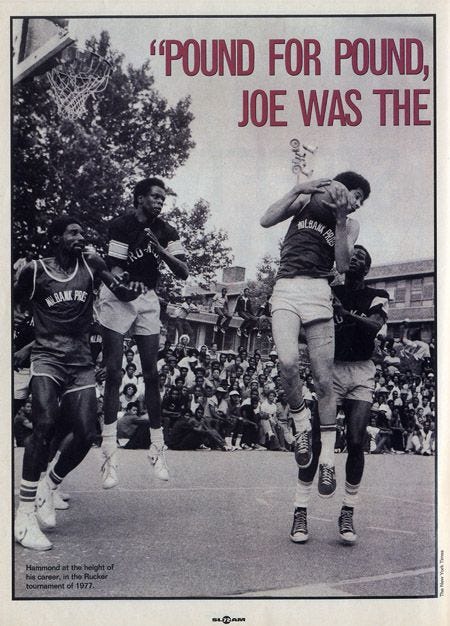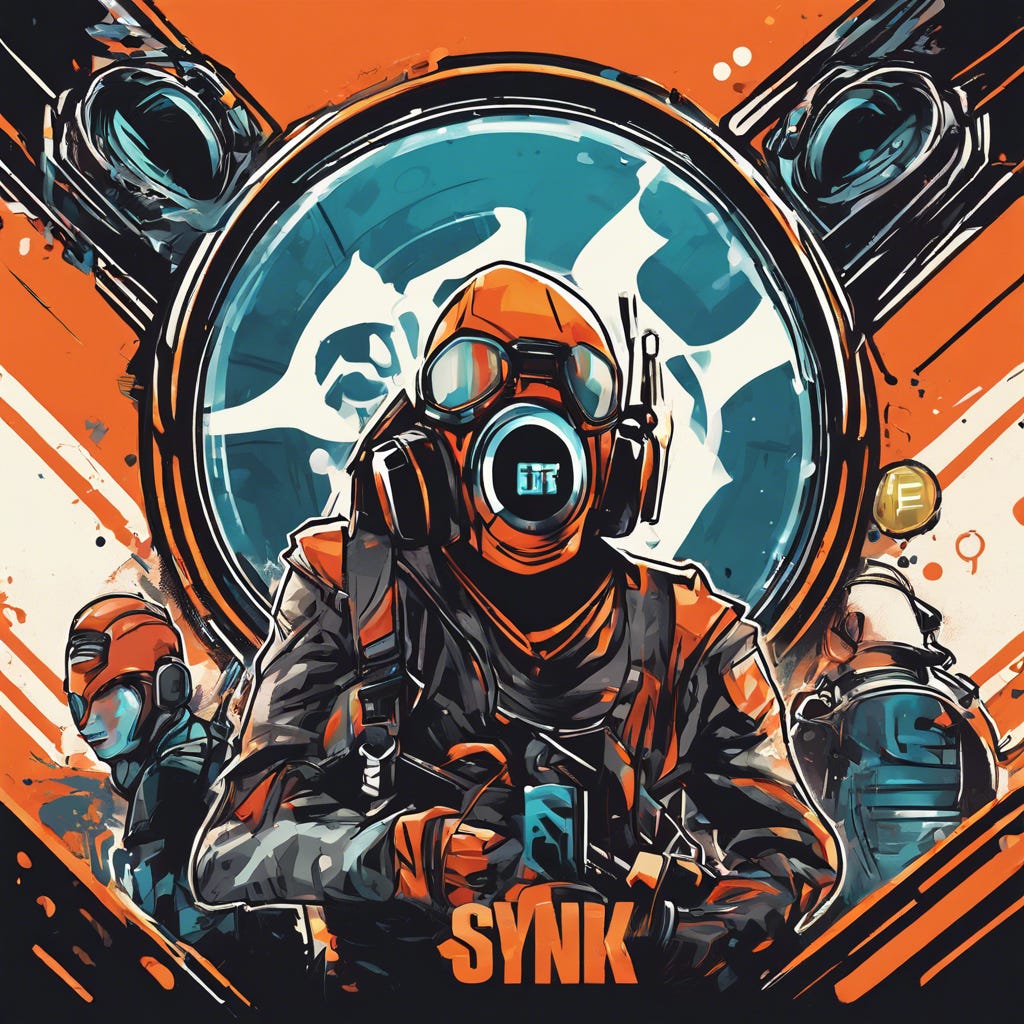Harlem’s Very Own Joe “The Destroyer” Hammond
New York born basketball players need to have more articles written about them. So I wanted to pay homage to the best street ball basketball player in New York History “The Destroyer”
My uncle just said to me while sitting next to him in the family business:
“Joe Hammond was one of the best of all time to never make it to the NBA. It was too much money in selling drugs back then, he would’ve been one of the greats. He used to come in the liquor store (Our family business) all the time. Good man, just the streets got to him.”
It’s towards the end of the summer late August with the dark days of no sports is behind us ladies and gentlemen. Thank god, I can’t take it going on a day to day basis with no sports to watch. Don’t get me wrong, I tune into The BIG3 by Ice Cube, Woman’s basketball, the yankees during the playoffs.
“Don”t kill me please I’m not a baseball fan at all”
This is the Yankees I was introduced to, and I’m talking I’m the person who turned the tv channel, yes the black tv with the illegal cable box to the Yankees. Watching this series in real team each night it came on I didn’t understand the history in front of my eyes but what an epic choke job by the yankees.
Another sport that I loved during the summer was AND1 basketball, as I previously wrote about the sport in another article. AND1 StreetBall Culture
Real quick why is NBA Streets Vol 2 so fire?
Back to AND1 Basketball, simple put it wasn’t your traditional basketball setting with ref’s, it’s far from that. The calls aren’t called the same, more freedom with the basketball offensively, and less foul calls on defense.
From that article I thought to myself “Who is the best street ball player of all time?”. So me I went and did my homework.
Meet Joe "The Destroyer" Hammond Harlem’s very own born 1949.
In a neighborhood where basketball was a way of life, the streets of Harlem were tough, and the game of basketball provided an escape. Think about those times back then, the cost of gas, the cost of rent, and going into the Civil Rights Movement.
From an early age, Hammond was drawn to the courts, where he quickly developed a reputation as a player with extraordinary skills.
As a child, Hammond attended Taft High School in the Bronx, but school was never where his heart truly was. He dropped out in the ninth grade, a decision that kept him off the radar of college scouts and made the traditional path to basketball stardom unlikely. Let’s be real, these men back in the 1950s-1990s trying to feed their families and the wages back then you can barely feed a snail. What alternative’s in those times these men had to survive besides either go to school or sell drugs.
But the streets of Harlem were where Hammond would make his name, not the polished floors of college gyms.
By the time he was a teenager, Hammond was already a force on the local playgrounds. His jump shot was smooth and effortless, his ball-handling skills were unmatched, and his ability to read the game set him apart from others. It wasn’t long before he became a regular at Rucker Park, the legendary court in Harlem where the best players in the city—and sometimes the world—came to prove themselves.
Rucker Park in the 1960s and 70s was more than just a place to play basketball; it was a cultural institution. The summer leagues there attracted NBA stars, college standouts, and local legends, all vying for supremacy on the asphalt. It was in this crucible of talent that Joe Hammond truly earned his nickname, "The Destroyer." His ability to take over games was nothing short of extraordinary, and word of his exploits quickly spread beyond Harlem
One of the most famous games in the history of Rucker Park took place in July 1971. The game featured a team called the Westsiders, coached by Peter Vecsey, a Hall of Fame writer for the New York Daily News. The Westsiders were led by NBA All-Star Charlie Scott and the legendary Julius "Dr. J" Erving. On the other side was Milbank, Hammond’s team, which also featured another streetball legend, Pee Wee Kirkland.
The game was anticipated as one of the greatest matchups in streetball history, drawing a massive crowd. But as the game started at 2 PM, there was a problem—Joe Hammond was nowhere to be seen. The tension in the park was palpable as the Westsiders began to take control of the game. Fans hung from gates, climbed buildings, and did whatever they could to catch a glimpse of the action.
This team featured future NBA stars like Billy Paultz and Dean Meminger as well. Once again, Hammond arrived late, strolling into the game during the second half. His reputation preceded him, and the Westsiders quickly assigned Scott and then Erving to guard him.
Hammond responded by scoring 50 points in the second half, outdueling Erving, who finished with 39 points. Milbank won the game, and Hammond was named the most valuable player. It was performances like these that solidified Hammond’s status as a streetball legend, arguably the best to ever play the game on the playgrounds of Harlem.
That same year, 1971, Hammond’s talent caught the attention of the NBA. The Los Angeles Lakers selected him in the first-ever Hardship Draft, a new rule that allowed players to enter the NBA early if they could prove financial need. The draft was a way for the NBA to relax the rules that required players to stay in school for four years. For Hammond, a high school dropout, this was a unique opportunity to take his game to the highest level.
The Lakers, led by stars like Jerry West, Wilt Chamberlain, and Elgin Baylor, offered Hammond a contract worth $50,000—a significant amount of money at the time. But Hammond’s life had taken a different direction. By then, he was deeply involved in the Harlem drug trade, making far more money than the Lakers were offering. In fact, Hammond later revealed that he had over $200,000 stashed in his apartment, earned from dealing heroin and marijuana.
For Hammond, the allure of the NBA wasn’t enough to pull him away from the life he had built on the streets. He believed he could beat any of the Lakers’ star players, and considering they were making $200,000 a year, he saw the $50,000 offer as insulting. At the time, Hammond owned a nightclub, two fancy cars, three apartments, and a house. In his mind, he was already living the life of a star player.
Hammond wasn’t just a streetball legend—he was a businessman, albeit one operating outside the law. His confidence in his abilities and his lifestyle made it easy for him to turn down the Lakers’ offer. He felt that his place was in Harlem, where he was already a king. The NBA, with its rules and structure, didn’t appeal to someone who thrived in the freedom of the streets.
Despite his immense talent, Hammond’s involvement in the drug trade would eventually catch up with him. He was arrested multiple times and served two prison terms for his involvement with drugs. His first stint in prison came in the 1980s, where he spent time at Rikers Island. From 1985 to 1988, Hammond was incarcerated at Camp Gabriels Prison in Lake Placid and the Clinton Penitentiary in Dannemora, New York.
Throughout his life, Hammond had brief encounters with the professional basketball world. In 1970, he played one year of professional ball with the Allentown Jets of the Eastern Basketball Association. During that season, he earned a spot in the league’s all-star game, where his electrifying play continued to wow fans. But the Jets only paid him $375 per game, which, while convenient, couldn’t compare to the money he was making on the streets.
Despite his brushes with professional basketball, Hammond’s heart was always in Harlem. His decision to turn down a three-year, no-cut contract with the American Basketball Association’s (ABA) New York Nets, coached by Lou Carnesecca, was another example of his commitment to the streets. Carnesecca, who later became a Hall of Fame coach at St. John’s University, saw in Hammond a player with tremendous skills and a bright future. But Hammond wasn’t interested. The ABA was still a young, unstable league, and Hammond felt he could do better.
Hammond’s life was a series of choices that kept him rooted in Harlem. The money, the fame, and the lifestyle he had on the streets outweighed the allure of the NBA or ABA. He was a precursor to players like Magic Johnson, a point guard with size, skill, and charisma. But unlike Johnson, Hammond never took his talents to the professional stage in a meaningful way.
In Harlem, people still talk about Joe Hammond with awe. Stories of him and Pee Wee Kirkland both scoring 50 points in the same game, or of Hammond scoring 74 points in a Rucker Park game, are passed down like legends. The only player to come close to matching Hammond’s feats at Rucker Park in recent memory was Kevin Durant, who scored 66 points in 2011 during a summer game.
Hammond’s decision to turn down the Lakers is one of the most talked-about "what if" moments in basketball history. What if he had signed that contract? What if he had played alongside Jerry West, Wilt Chamberlain, and Elgin Baylor? These are questions that can never be answered, but they add to the mystique of Joe "The Destroyer" Hammond.
In the end, Joe Hammond’s legacy is one of immense talent and untapped potential. He was a player who could have been one of the greatest, but his life took a different path. Despite his struggles and the choices he made, Hammond remains a legend, a player whose name is still spoken with reverence in Harlem and beyond.
Hammond’s story is a reminder of the power of choice, the allure of the streets, and the fine line between greatness and obscurity. He was a man who lived by his own rules, and for that, he will always be remembered as one of the greatest streetball players to ever grace the courts of Harlem. Joe "The Destroyer" Hammond may not have played in the NBA, but his impact on the game of basketball is undeniable, and his legend will live on forever.
Thankyou for reading, because of you I continue to write these article’s to keep the culture of New York flowing when I write. Also, sharing knowledge, basketball isn’t just about the NBA. Always, remember New York has so many stories to tell, depends on which story you choose to tell.
Thankyou, godbless and have a good day and night reader.








So many untruths!!! Told over so many years. It’s really sad!! And unnecessary!!